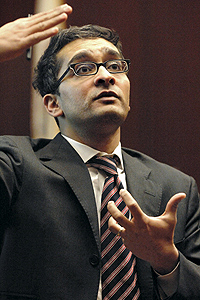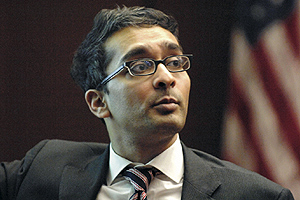Malani weighs economic, moral hazards of controlling avian influenza
By Sabrina L. MillerNews Office
 Anup Malani | |
Anup Malani, Professor in the Law School, was having lunch with Saul Levmore, Dean of the Law School, at Noodles Etc. on 57th Street, when he floated the idea that, in order to control the spread of avian flu, Third World governments may have to drastically raise the amount they compensate chicken farmers for their flocks when those flocks may be infected with the disease.
So passionate was Malani about his argument that he used chopsticks to construct graphs at the lunch table to illustrate his point. To Levmore, Malani’s theory was the perfect marriage of law and economics, and he asked Malani to give the Law School’s annual Coase Lecture on Law and Economics.
Malani presented “Culling Chickens,” to an overflow crowd at the Law School on Tuesday, Jan. 23. It gave the University audience the first glimpse of a topic that Malani has been invited to present to the World Health Organization in Geneva, Switzerland, this spring. The World Bank also has approached him to make a presentation about his research. Malani, who just rejoined the faculty in the Winter Quarter after spending the Fall Quarter as a visiting professor at Harvard Law School, also will present “Culling Chickens” at Harvard University in April.
Malani graduated from the Law School in 2000 and then received his Ph.D. in Economics from Chicago in 2003. He has clerked for U.S. Supreme Court Justice Sandra Day O’Connor and for Judge Stephen Williams of the U.S. Court of Appeals for the D.C. Circuit. Malani said he believes the World Health Organization might be interested in his views on culling chickens because his legal and economic perspective differs from the perspectives of epidemiologists also working on these issues.
Although not yet widely considered a problem in the United States, avian flu has reached endemic status among chickens in Southeast Asian countries like Indonesia and has spread quickly in other South Asian, African and European countries. More than 200 million birds have been killed because of avian flu concerns, Malani said. He added that in the worst case scenario where the virus learns not only how to jump to humans but how to spread easily among them, it has the potential of killing more people worldwide than the 1918 influenza pandemic, which killed an estimated 50 to 100 million people in just 18 months.
“Avian flu is still a serious threat. It’s a small problem now but it is growing at a very, very fast rate,” Malani said. “If it began to spread among humans, its impact could dwarf the number of deaths in the Iraq War. If it hits here, it could be huge.”
Governments trying to prevent avian flu outbreaks among humans frequently attempt to cull chickens before they spread the disease to humans. Farmers in Third World countries need chickens for income and therefore resist surrendering chickens for culling. Malani argues that governments can overcome this obstacle by either buying chickens or banning the sale of chickens and giving farmers no option but surrendering them to the government. Either option, he said, faces challenges.
 Anup Malani | |
If the government wants to buy chickens, but farmers don’t think they are being fairly compensated for their chickens, they will sell their chickens to the private market rather than the government or try to “save” their chickens to sell next season. Nevertheless, rather than paying chicken farmers the market price or higher for healthy chickens, governments most often pay the “lemon price”or lower—that is a price that accounts for the possibility that the chickens are diseased, Malani said. It is often impossible to detect whether the chickens have been infected with the deadly virus. He argues that even if governments were to offer sufficient compensation, they would face a second problem; farmers would be fully insured against avian flu and they would take less effort to prevent their chickens from becoming infected in the first place.
Banning chickens does not have this perverse incentive, he notes. But banning chickens for only one season may be insufficient to eliminate sick chickens because of the farmers “saving” the infected chickens until the next season.
Malani concedes that there are no easy solutions in trying to control avian flu, but concludes that banning chicken sales may be preferable to the government trying to buy them. He came to this conclusion in part because of the moral hazard and in part because chickens may not survive for very long with the flu. The basic lesson, Malani said, is that “Incentives matter for infection control. This can lead one to policies that differ from common-sense policies.”
Levmore praised Malani’s research and the lecture, saying, “It took a simple tool, that of moral hazard, and showed how moral hazards were embedded in one another when governments sought to pay chicken farmers to destroy or give up their chickens as part of a plan to fight avian flu.
“Apart from formidable technical skills, Anup brings imagination to his work,” Levmore said. “This, and considerable wit and ability to conjure examples.”
The Coase Lecture is named for Nobel Prize-winning economist and law professor Ronald Coase, the Clifton R. Musser Professor Emeritus of Economics in the Law School. Held annually since 1992, the lecture was designed as an analytical tool of law and economics for first-year law students but has proved compelling enough to draw crowds from throughout the University community.
Previous Coase lecturers have included Randal Picker, the Paul & Theo Leffmann Professor of Commercial Law and Lior Strahilevitz, Assistant Professor in the Law School. Many of the papers that have been presented are published in a volume called Chicago Lectures in Law and Economics.
![[Chronicle]](/images/sidebar_header_oct06.gif)